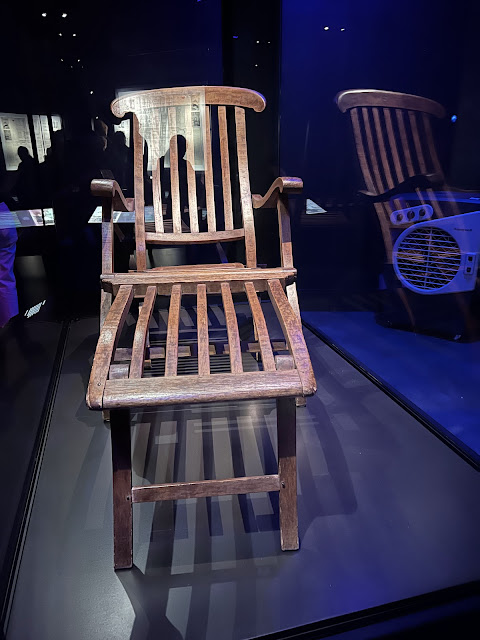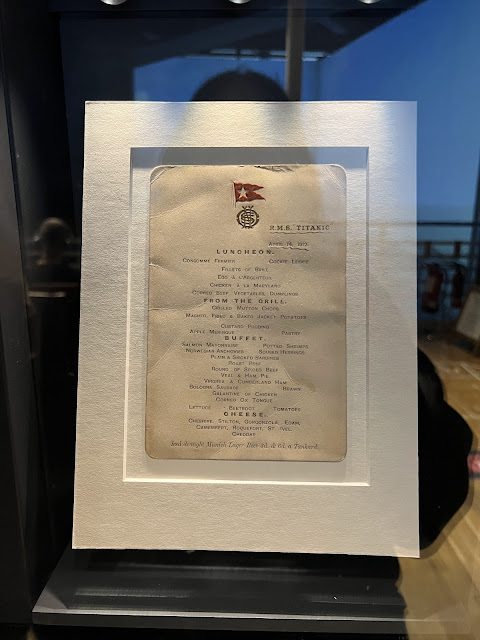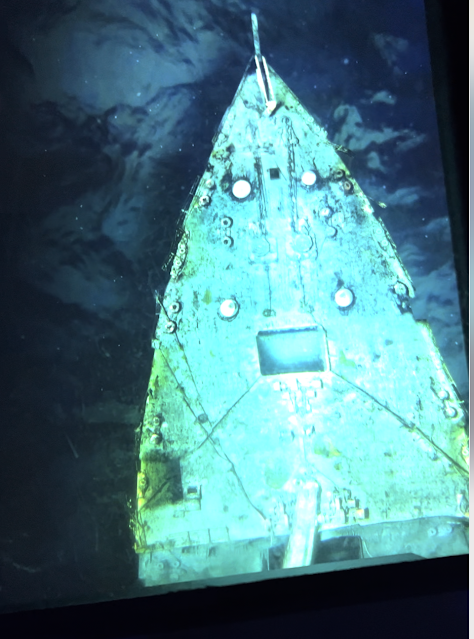My best friend Andrew and I watch
Titanic every Valentine's Day. It's been a tradition for years, and in recent times includes his fiancé, Nicholas. We can quote every line, we know the ins and outs of the history, we discuss how the artifacts are represented. It doesn't feel right to say I'm obsessed with the Titanic, but it's difficult to know how else to describe a fascination that's gone back decades at this point (especially since I saw the movie in the theater five times when it came out in 1997).
It seems obvious, then, that I simply had to visit Titanic Belfast when I was in Ireland. This museum still had me learning new stories and seeing artifacts I didn't even know existed. The sinking is one of the most heartbreaking tragedies in history, and I thought the way the museum handled it was absolutely perfect. Keep reading to discover the 15 reasons you should visit Titanic Belfast.
1. They have one of the last remaining deck chairs from the ship.
This is one of only six remaining deck chairs from the ship. It was found floating in the water by the Mackay-Bennett, which was the first of four ships chartered by the White Star Line to search for bodies after the sinking.
 |
One of the last remaining deck chairs from Titanic exists here.
|
2. Only 12 lifejackets still exist, including this one.
There were over 3,500 lifebelts (AKA life vests or lifejackets) on the Titanic — and only 12 are left. This Fosbery lifejacket was recovered from the wreck site by the Mackay-Bennett.
 |
One of only 12 lifejackets still in existence.
|
3. You're given White Star Line tickets to enter the museum.
If you want to live out your fantasies of feeling like Jack winning his ticket to Titanic, your entry ticket will help with that. Each ticket is printed to look like one you would hand to an attendant as you board.
 |
Enter the museum with your own White Star Line ticket.
|
4. Speaking of tickets ... the museum actually has one of the genuine tickets used for the launch.
This wasn't actually a ticket used to board the ship. On the day of the initial launch, people could purchase tickets to see the ship leave from the harbor in Belfast on May 31, 1911. Yes, this was almost a full year before the ship's trip from Southampton.
 |
A ticket used at the viewing of the ship's launch from Belfast.
|
5. If you were wondering how First Class passengers dined, you can see a menu from the last lunch on board the ship.
This menu belonged to passenger Ruth Dodge, and was for the First Class luncheon on April 14, 1912. Passengers could choose from a variety of foods, including chicken a la Maryland, grilled mutton chops, potted shrimps, soused herrings, and roast beef. The recovered menu even has a handwritten note from a ship steward who knew the family, which reads, "With compliments & best wishes from Frederic Dent Ray, 56 Palmer Park, Reading, Berks."
 |
A First Class lunch menu from the ship's last day.
|
6. The missing binocular box key was recovered and is on display.
This fact is actually briefly mentioned in Titanic, but I never caught it until after visiting Titanic Belfast — and I didn't know about it until then. This binocular box key belonged to Second Officer David Blair, who was reassigned just before the ship's maiden voyage. Because of his hasty departure, he kept the key in his pocket instead of leaving it on the ship, which meant there was no access to binoculars on the night of the sinking. The lookout, Fred Fleet, told the official inquiry that if he had binoculars, he would have seen the iceberg sooner.
 |
The ship's missing binocular key.
|
7. You can take photos on the First Class promenade deck.
As you walk through the museum, you'll come to the First Class promenade. At this juncture, there's a video showing what the view would have been like from the deck. It's also one of the areas where you can take a photo. I will admit that while most of the museum feels extremely somber, this is a part that attempts — however much in vain it may be — to slightly lighten the mental and emotional load.
 |
| A recreation of the First Class promenade deck. |
|
 |
The view from the First Class promenade deck.
|
8. Read some of the devastating last messages and distress calls sent from the ship.
One of the saddest things I came across in the museum was the distress calls sent as the Titanic was sinking. There are screens after screens of these messages sent to surrounding ships, crying out for help as the ship went down.
 |
All stations urgent distress call.
|
 |
Distress call mentioning putting women in life boats and sinking quickly.
|
 |
A distress call finishing with "CQ" ... silence. At 2:10am.
|
9. Learn more about Thomas Andrews, the managing director in charge of design for Titanic.
As a lifelong fan of Victor Garber, I've always had a special affinity for his portrayal of Thomas Andrews in Titanic. You can learn more about the actual Andrews and how he designed the ship.
 |
Thomas Andrews was the managing director in charge of design for Titanic.
|
10. See the actual violin played by Wallace Hartley as the ship went down.
This is one of the artifacts that truly shocked me. The violin, which belonged to Wallace Hartley, was a gift from his fiancée, Maria Robinson. The string quartet played on the deck as the ship sank, later inspiring the phrase, "And the band played on." While Hartley did not survive, his violin was later found floating atop the water within its case.
 |
Wallace Hartley's violin was found within its case.
|
11. Discover an original First Class accommodation plan, which was issued to Ida and Isidor Straus.
If you've watched Titanic, you may remember the old couple holding each other in bed as the ship finally sinks. The two people were Ida and Isidor Straus, who owned Macy's department store in New York City. They were issued a First Class accommodation plan to help them navigate the ship. Their story is truly incredible — instead of trying to fight for survival, Ida insisted that their personal maid, Ellen Bird, would go in their place. She had this plan in her possession when she was saved.
 |
The first class accommodation plan given to Ida and Isidor Straus, and rescued by their personal maid, Ellen Bird.
|
12. See a pocket watch that stopped the moment it went into the ocean.
Malcolm Joakim Johnson was wearing this pocket watch the night he died. The hands of the corroded Omega are frozen in time at 1:37a.m., which is the moment Johnson went into the ocean.
 |
A pocket watch that stopped the moment its owner went into the ocean.
|
13. Stand over the sunken ship as it floats by.
One of the most haunting areas of the museum is a glass-bottomed floor where you can watch the wreckage of the Titanic float past. The entire video takes a couple of minutes.
 |
Stand atop the ocean depths and watch as the Titanic floats by.
|
 |
Another shot of the Titanic down below.
|
14. The museum building actually looks like the Titanic.
Yes, the building you enter looks like the ship itself. It's just one more way that the Titanic Belfast immerses you in the experience from the moment you arrive.
 |
Titanic Belfast is built to look like the actual ship.
|
15. Finish your visit at the bow of the ship.
Yes, you can take a photo at a recreation of the bow of the ship and feel just like Leo and Kate. It was actually difficult to want to smile here, after witnessing everything I had. But it adds one last moment of lightness to an otherwise tragic tale.
 |
|
| The museum has a recreation of the ship's bow. |
|
|
|
|





















No comments:
Post a Comment